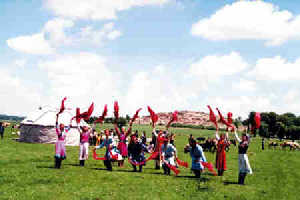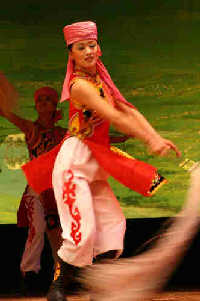 Andai and Andai Dance in Inner Mongolia
Andai and Andai Dance in Inner Mongolia
 Andai dance originated from a collective dance of the Kulun Qi in the south of the Horqin Grassland. At first, it was a religious dance used in praying to the god and curing sicknesses. People would perform this dance to impetrate the blessing of the god, to prevent diseases, and to forestall misfortunes. Later, the dance gradually became a way of entertainment.
Andai dance originated from a collective dance of the Kulun Qi in the south of the Horqin Grassland. At first, it was a religious dance used in praying to the god and curing sicknesses. People would perform this dance to impetrate the blessing of the god, to prevent diseases, and to forestall misfortunes. Later, the dance gradually became a way of entertainment.
Traditionally, participants usually stand in a circle, singing and dancing with silk scarves in their hands. The major dance is stamping on the ground or slowly moving sideward while swinging silk scarves. Although easy to perform, Andai dance now contains some deep social meanings.
One can never have a better understanding of Andai dance until he or she knows how it was created, developed, and spread widely among the common people.
Due to their special language system, the local ecology, and the historical background, most of the Mongolian people for centuries have embraced the shaman religion. In ancient times, they always participated in religious rituals (shaman powwows) presided by a shaman to pray for a happy life and rich harvests. As time went on, people created rituals with different aims, and so accordingly, different titles for shaman powwows came into being. Andai was the title for powwows whose major mission was to help out or encourage young woman who suffered from unhappy marriage.
 As to the origin of Andai dance, there are many widespread stories. One of them goes like this: Long ago, there lived a father and his daughter on the Horqin Grassland. One day, the daughter, suddenly stricken by an unknown disease, lost her mind and acted oddly. She remained ill for a long time without any sign of recovery. One day, the father, burning with anxiety, carried his daughter on a herdsman's wooden cart to a faraway place to see doctors.
As to the origin of Andai dance, there are many widespread stories. One of them goes like this: Long ago, there lived a father and his daughter on the Horqin Grassland. One day, the daughter, suddenly stricken by an unknown disease, lost her mind and acted oddly. She remained ill for a long time without any sign of recovery. One day, the father, burning with anxiety, carried his daughter on a herdsman's wooden cart to a faraway place to see doctors.
However, when they arrived at the town of Kulun, the axle of the cart broke down. Just at that time, the girl's disease became serious and her life was in danger. The anxious father had no idea what to do except to wander around the cart, singing a song to express his sorrow. The wailing song drew some people from the nearby villages. They couldn't help shedding tears at this sight and voluntarily followed the old father, swinging arms, stamping feet, and crooning plaintively.
To everyone's surprise, the daughter rose quietly, got off the cart, and followed the people, swinging her arms and stamping with them. When people saw her, she was sweating all over, and her disease miraculously cured. The good news spread and from then on, people began to follow suit and treat young women who suffered from similar diseases in such a way of singing and dancing, which was named "Andai."
